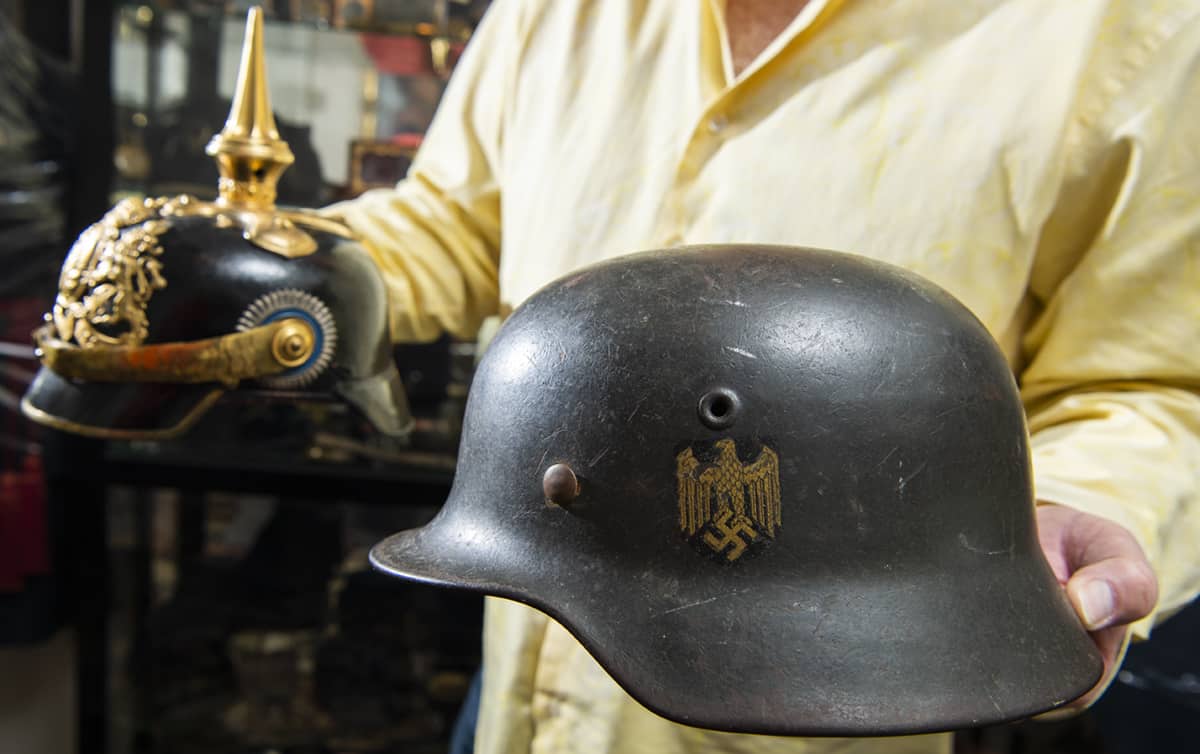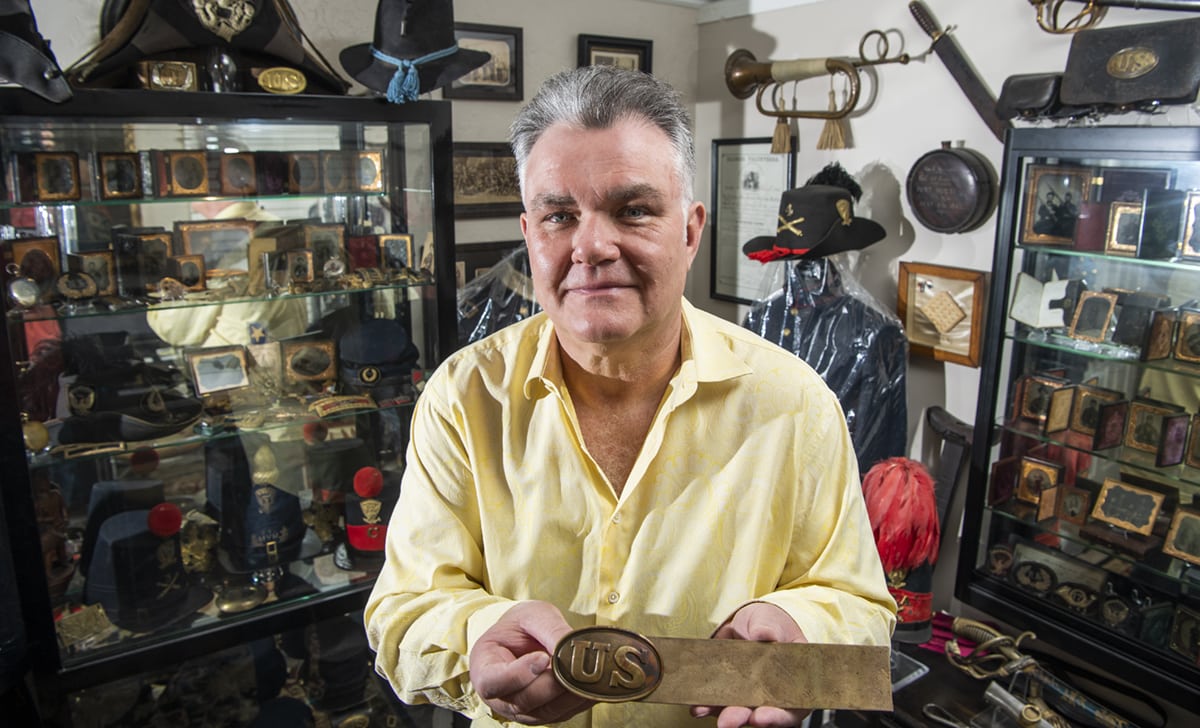Long Beach resident Bruce Hermann is tall, with gray hair and an easy smile. If he looks familiar, it’s probably because he appeared on the PBS program “Antiques Roadshow” for 11 seasons. Friendly and highly intelligent, he’s also a bit security-conscious. Though we talked on the phone a few times before meeting, he asked to see my ID a few moments after I first shook his hand. It’s nothing personal, he told me, it’s just something he has to consider, given his line of work.
Hermann deals in the world of military antiques and artifacts. He and his business partner Kevin Finley run Grenadier Auctions, which functions much like an eBay for military items, though with some differences. People send him their collectibles—or in the case of large collections, Hermann and Finely will pick them up—which they evaluate. The items have to be original and unchanged. All auctions happen online, and bidding lasts for two weeks.
Look at the Grenadier website now and you’ll see that the vast majority of items there for sale are from Nazi Germany. To be clear, most of this stuff has been around since the end of the war.
“A lot of it was brought home by GIs as souvenirs and war trophies,” Hermann said. “Huge amounts of stuff.” And now, with so many World War II veterans dying of old age, a lot of these items are now entering the market. And the prices just keep climbing.
“When I bought my first helmet at the age of 10 in 1969, I paid $35 for a double decal Allgemeine-SS helmet,” Hermann told Military Trader in 2015. “Today, that very helmet would bring in excess of $20,000. This has turned into what can be an expensive hobby—however, there are still many affordable items for any level of collector.”
Let’s be clear: Bruce Hermann is not a Nazi or a Nazi sympathizer. He opposes all the views of national socialism and hates Hitler and skinheads. He’s 60 now and has been collecting military items since he was about 8 years old. His house is filled with antiques—especially vintage radios. He turned his hobby into a full-time occupation in the 1990s, eventually becoming so esteemed in the world of military collecting that he got the gig as an appraiser on “Antiques Roadshow.”

But everywhere you look, it seems that Nazis are on the march. They’ve been with us since before World War II (anyone who’s watched the History Channel in the last decade knows Nazis are as popular there as sharks are on the Discovery Channel), but mostly stayed in the shadows. That’s changed in the last few years and now, they seem to operate far more openly, i.e. tiki torches.
And right now, authentic Nazi items—weapons, clothing, badges, armor, etc.—are extremely valuable. In fact, 14 of Adolf Hitler’s paintings sold in 2015 for $450,000, according to a Feb. 6 “Forward” story. So why is this stuff so popular now?
“Hollywood has a lot to do with it,” said Hermann, who pointed out that there was a huge uptick in the value of Civil War items after the 1989 release of the movie “Glory.” And when “Band of Brothers” first aired on HBO in 2001, “American paratrooper stuff went wild.”
Paul Shull understands this well. His show “The Weaponhunter,” which examined the world of men (and it was always men) who collect historic weapons, ran two seasons on the Smithsonian Channel. He said he’s met hundreds of collectors, who’ve allowed him to examine and even hold not just rare rifles and swords, but also more intimate items.
“I’ve held Hitler’s coffee cup,” Shull said. “I’ve held Hitler’s watercolors. It’s the eeriest, strangest feeling you can imagine. There’s a certain allure to that.”
Shull calls Nazi items “the dark stuff,” which, he said, helps explain their popularity.
“Because they’re so hard to get, certain collectors are driven to get these items. Or items with an evil stigma attached to them.”
As to who is buying all this stuff now, that’s an equally complicated question. Hermann said his clients range from a kid who works in a hardware store to a brain surgeon. He even says he has a couple of Jewish clients who collect Nazi and SS items.
“It’s anybody who has an interest in history,” Hermann said, who adds that he would never knowingly sell anything to someone who would “misappropriate” these items. “I’ve never met anyone who collected Nazi items who I would say was a neo-Nazi.”
Shull said much the same thing. He’s met hundreds of military collectors, he said, and wouldn’t describe any of them as Nazis. “These are lovers of history,” he said. “To me, they’re big kids. Collectors are so competitive, there’s an alpha streak in these people. They have to have something. They will go to any length to get it. There’s only a certain number of these items, and the rarer they get, the more the alphas want them.”
Though there was that one time when Shull felt very uncomfortable visiting a collection.
“I didn’t know whether to cry or punch him in the face,” Shull said. “I left the room. I go with my gut, and this wasn’t cool. There was a human skull there.”
For Dr. Stanislav Vysotsky, a sociologist at the University of Wisconsin-Whitewater who has extensively studied white supremacist groups says the very fact that Nazi items are so prevalent and valuable is a problem. “Context matters a lot,” he said. “White supremacists collect these things because they’re viewed as prized possessions. By having these, it gives you status. It’s about achieving status in a small world.”
Vysotsky described the time he and his partner visited an antique mall in a small Wisconsin town a few years ago. There he found a display case containing Nazi antiques, but then he noticed that mixed in with them was contemporary Nazi imagery. “We were thoroughly offended and we walked out,” Vysotsky said. “They were trying to sell this material to others who had a similar ideology.”
Hermann says this “taboo” on collecting Nazi items didn’t exist when he was a kid, just starting out. “I don’t look at it politically,” he said. “I’m a historian at heart. To me, every aspect of history has to be accounted for. If you squelch things, then you don’t remember them.”

That being said, Hermann doesn’t collect Nazi items, himself. In fact, he has no interest in them whatsoever, regardless of their value. Instead, he collects Union Army items from the Civil War. He has lots of very old photographs of soldiers, some far sharper than you might imagine given the very primitive glass plate tech of the time, and even a couple hardtack biscuits, one that is dated, authenticated, and framed. He has uniforms, carefully draped over mannequins and covered in plastic, and a few swords, too, including one saber painted a striking cobalt that can never be duplicated because it’s made from whale oil.
He also owns other, far more poignant items, that point to the human side of this kind of history. A section of a Union soldier’s belt and buckle contains, on one side, the soldier’s name which had been stenciled and, on the other, stains from the blood that poured out of the soldier as he lay dying on the battlefield.
“For me, history is a tactile experience,” Shull said, a sentiment Hermann heartily agrees with. “It needs to be touched, needs to be smelled. You have to be around the objects.”

